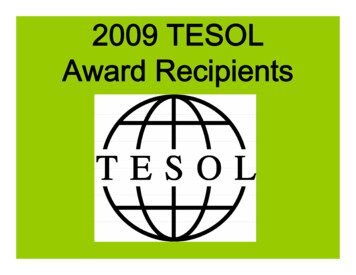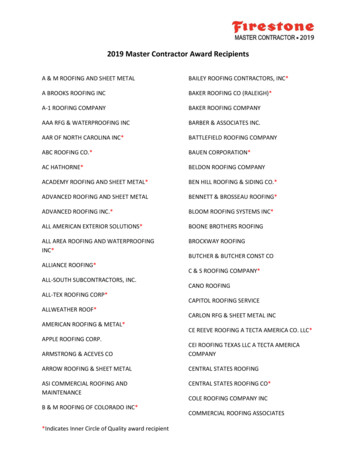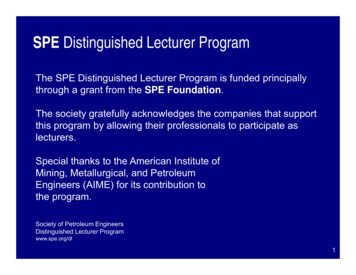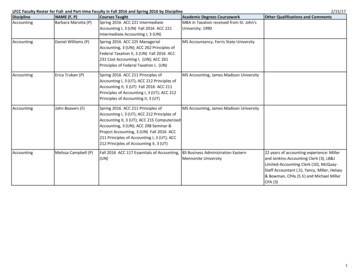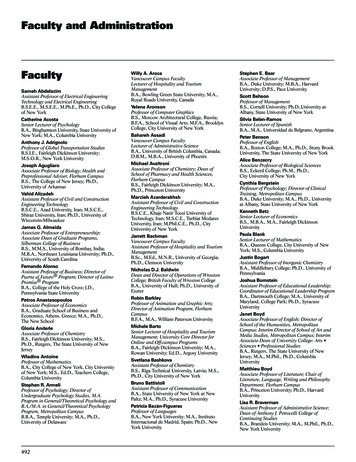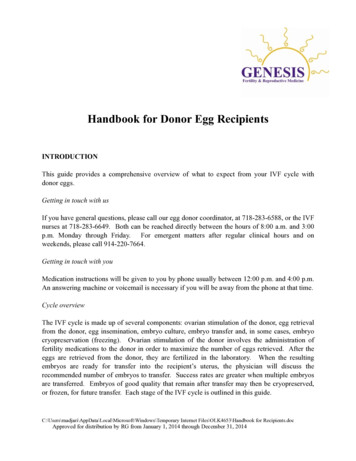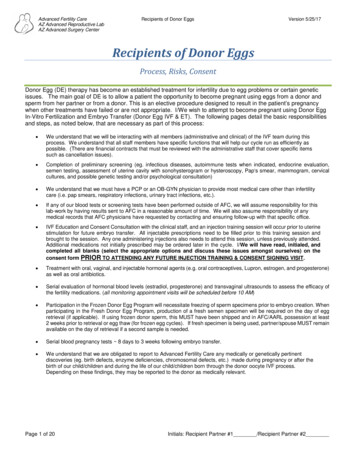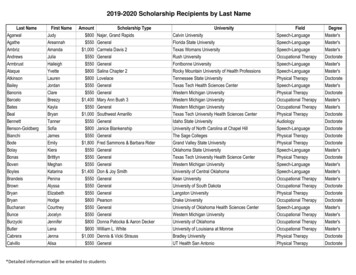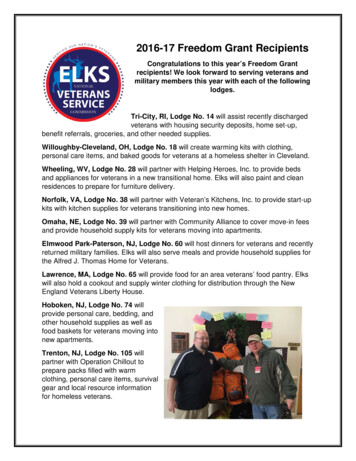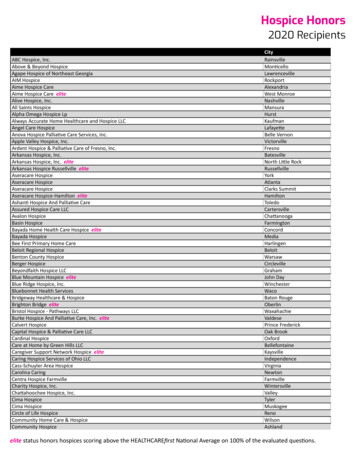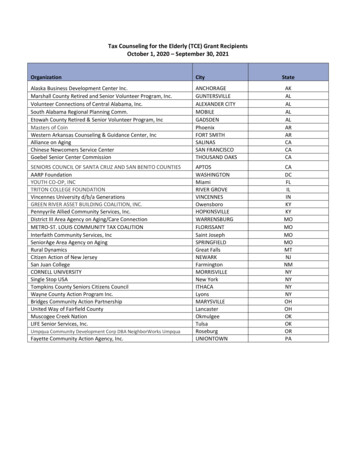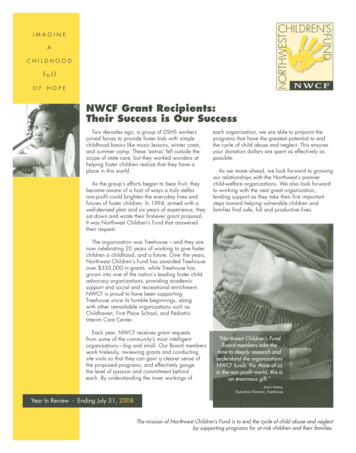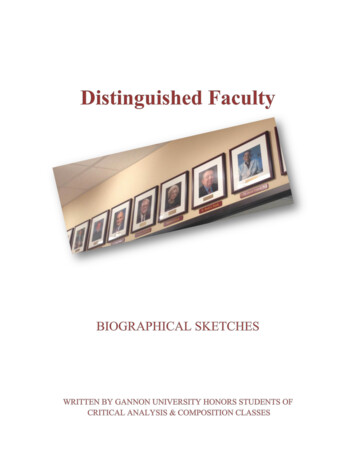
Transcription
Distinguished Faculty Award Recipients and Student Authors1984Dr. Richard BeyerDr. James FreemanDr. John FlemingAbby WuMylinda HartnettMylinda Hartnett1985Prof. William N. LatimerRev. Msgr. James McCulloughDr. Stanley ZagorskiAmanda BachmanKatharine ResslerHannah Merrifield1987Prof. Edward E. RogersDr. Berta M. WeberDr. J. Jacob YoungPaul LeVanDanielle MunseeJacob Gorton1988Dr. Matti MoosaRev. Edward Q. FranzDr. Charles LundyAnnie HattonKatharine ResslerDavid Batistic1989Dr. David EichelsdorferDr. Elmer Frank KohlmillerDavid BatisticEvan Miller1990Dr. Dolores SarafinskiRev. Msgr. Richard SullivanSr. Lucille DeStefanoSabirah ChenRachael LucianoEmma Oros1991Dr. John P. SuskoDr. John S. RouchJacob GortonGreg Newman1992Dr. Frank PizzatRev. John P. SchanzYang ChenDaniel Hansen1993Dr. Paul Ward PetersonProf. Catherine SeiboldLisa FerantiSamantha Dorn1994Dr. Charles M. MurphyDr. Halit KosarAvery CraigSabirah Chen1995Rev. Msgr. Gerald L. OrbanekProf. Thomas J. LeonardiDr. Michael L. BucholtzKatharine ResslerRachael LucianoPaul LeVan1996Prof. Sally E. SchusterSamantha Dorn1997Dr. Samuel Lyle HazenJesse Nych1998Dr. Cherie Ann HaegerProf. Mary Sue SmithHannah MerrifieldAmanda Mock1999Prof. David J. GustafsonJames Gruss
2000Dr. Mehmet CultuYang Chen2001Dr. Mahesh C. AggarwalDr. Kenneth AndersonNicholas ErdlandNicholas Erdland2002Dr. Walter S. MinotDaniel Hansen2003Dr. Michael J. PanzaGiona DiMarco2004Dr. Marjorie J. KrebsAmanda Mock2005Dr. Terry GilesHannah Merrifield2006Dr. Philip H. KellyDaniel Hansen2007Prof. Anthony J. (A.J.) MiceliPaul LeVan2008Rev. Robert P. SusaDr. Hamid TorabAmanda GranataJacob Gorton2009Dr. Thomas S. OstrowskiAvery Craig2010Prof. Annmarie GeorgeAmanda Granata2011The Very Rev. Father Joseph GregorekDr. David C. KozakAmanda BachmanDanielle Munsee2012Prof. Berwyn J. MooreSabirah Chen2013Dr. Karinna M. VernazaLisa Feronti2014Dr. Suzanne RichardAbby WuMany thanks go to Nash Library Archives Librarian Robert Dobiesz, who guided students as theyindividually studied documents, read testimonials, and selected photos. Also, thanks to Dr. AnnBomberger, director of the Honors Program, who supported this project throughout the semester andDeborah West, Nash Library Reference/Instruction Librarian, who provided information about FacultySenate. To faculty and staff in University Mission & Ministry; College of Humanities, Education, andSocial Sciences; Villa Maria School of Nursing; and Occupational Therapy: thank you for insights on theuse of appropriate titles and referencing. And to Annie Hatton: thanks for the cover photo. In matterslarge and small, students whose work you read here have proven themselves to be curious, insightful, anddedicated to sharing discoveries. In other words, they have approached research in admirable ways, andwe’re all the richer for it.Carol Hayes, Department of EnglishGannon UniversitySpring, 2014
Lining the hallway of the first floor of Gannon University’s Palumbo Academic Centerare portraits of faculty members dating back through the decades. These portraits depict therecipients of Gannon’s annual Distinguished Faculty Award, starting from the mid-1980s, andcontinuing up to the current year. Despite the prestige of this decoration, many students, andeven staff members, are unaware of the dedication and work that these teachers have shownthroughout their careers at Gannon. In an attempt to rectify this oversight, Professor CarolHayes introduced a project to her Honors Critical Analysis and Composition classes in which thestudents would research and document the accomplishments of the Distinguished Faculty, so thatothers would be able to access the information. Through the hard work of the students, underProfessor Hayes’s guidance, the project was proudly displayed at the 2014 Celebrate Gannonfestival.Throughout the Spring 2014 semester, students researched the professors by visiting thecampus archivist and conducting interviews. Next, the information was organized, andindividual biographies were written, focusing on what the professor did while at the university,and what merited them the honor of Distinguished Professor of Faculty member. Research wasalso done concerning the nature of the award and its origins. Between 1955 and 1956, GannonUniversity established what is known as the Faculty Senate, whose mission is “representing thecollective faculty view in matters of concern to the faculty as a whole assuring the effectivemeans by which the faculty participates in the governance of the University.” One of theresponsibilities that the Senate took on was to name a Distinguished Faculty member. Initially,more than one could be named per year, but this was narrowed down to a single award per year,making it that much more honorable. To be eligible, nominees simply need to have six years asa full time faculty member. To receive the award, however, the faculty member must showoutstanding leadership, performance, influence, and dedication resulting in “growth anddevelopment, within the University and/or in the community.”Obviously, these professors have earned the respect of the Gannon community, and it isimportant that they be honored appropriately. Looking back on the accomplishments of theseprofessors and clergy members only makes it more exciting to see who will be next. We hopethat this project will continue to document future Distinguished Faculty members out of respectfor their dedication and for the good of the Gannon family.By Evan Miller, one of 26 Honors students of Critical Analysis & Composition, 2014
1984Dr. Richard BeyerDr. Richard Beyer, born April 27, 1905 to Richard and Mary Beyer in Erie, Pennsylvania, attendedAllegheny College and Illinois State University and achieved his doctoral degree in Colonial AmericanHistory. He started his career at Gannon in 1946 and it only grew from there. More widely known as“Doc Beyer,” he was a history teacher, director of the Department of History, and the director of theGraduate Faculty of the Social Sciences. During his twenty years working at Gannon (1946-1966), DocBeyer became well known for his teaching style that typically included chalk, a chalkboard, and hischaracteristic address towards the students: “Now, class.” In addition to his classroom teaching, Dr. Beyeralso spoke at several organizations and moderated the Gannon Roundtable Series on the radio.Interestingly, Doc Beyer was the co-author of two books, multiple monographs, book reviews, andencyclopedias.Dr. Beyer received the Distinguished Faculty Award due to his dedication to working with and trulyteaching his students. In his memory, there is also an annual Richard Beyer Memorial Lecture in which adifferent speaker is invited each year. Until his death on August 7, 1966, Dr. Beyer was well known forhis charity and comedy towards his students, which added to his eligibility for The Distinguished FacultyAward on April 29, 1984.By Abby Wu
1984Dr. James FreemanDr. James Freeman was one of three to be first awarded the Distinguished Faculty Award by GannonUniversity on April 29, 1984. Born in 1913, Freeman was a native of Erie and passed away in 1980 due tocancer, four years before he was recognized with the award.Dr. Freeman was the son of James and Jeanette Freeman and was married to Laura Bundy; they hadfive children. He attended Cathedral Preparatory School and earned his bachelor’s and master’s degreesin science from the University of Pittsburgh in 1935 and 1942, respectively. Additionally, he earned anhonorary degree from Gannon College in 1978. Dr. Freeman taught at Cathedral Prep, Erie Tech, and ErieVeterans School as a math teacher until his transfer to Gannon College to become a professor ofmathematics and eventually the director of the Mathematics Department. He was an active member in thecommunity through his church, St. Luke’s Parish, and chairman of Erie Parking Authority. Dr. Freemanwas recognized with the Distinguished Faculty Award for the numerous hours he dedicated to helping hisstudents outside the classroom with mathematics as well as their personal problems. He was known forhis ability to effectively teach African American students by earning their trust and confidence to helpthem succeed. Dr. Freeman held special programs to help further educate the African American studentsof Gannon in a time when segregation was still influential in our society. A memorial scholarship wasestablished in honor of James Freeman by Gannon alumni in memory of the many lives he touched as ateacher, mentor, and friend. Dr. Freeman was described by colleagues as “A great man, a great Christian,and a great father with integrity, who lived what he said and was a real, wholesome person.”By Mylinda Hartnett
1984Dr. John FlemingDr. John Fleming was awarded the Distinguished Faculty Award by Gannon University on April 29,1984. He had served the university in various capacities for 36 years. Dr. Fleming, born in 1918, was anative of Erie and was the son of James and Helen Fleming. He was married to Mary Gallagher in 1946and they had three children. He attended high school at Cathedral Preparatory School and moved on toGannon University to receive his bachelor’s degree in 1936, then Fordham University to earn his master’sdegree in 1951, and finally the University of Ottawa, Canada, to earn his doctoral degree in 1962, alldegrees in psychology. Dr. Fleming was the chief clinical psychologist at the Erie Child Guidance Centerfrom 1952 to 1964, Secretary of the Personnel Department at Gannon University, President of the Boardof Directors of Stairways, a member of St. Andrew‘s Catholic Church, the Erie Irish Cultural Club, theErie Maennerchor Club and the East Erie Turners, as well as the Human Relations Commission. Beforehis death in 1998, he was a prominent member in the community, well known for his long-standinginterest in parapsychology. He became established as Erie’s favorite “ghost buster.” Dr. Fleming washonored with the Distinguished Faculty Award for his numerous published articles dealing withparapsychology. He faced professional adversity during that time period, given the controversial nature ofthe subject, and his subsequent enduring strength and wisdom. He was known for his dedication andtolerance when it came to working with both students and colleagues, and his sense of fair play, whichearned him the unequivocal respect and trust of all. In summary, Dr. Fleming was described by colleaguesas “one of the best and most scholarly professors at Gannon.”By Mylinda Hartnett
1985Prof. William N. LatimerWilliam N. Latimer was honored posthumously with the Distinguished Professor Award in 1985, ayear after his death in 1984. He worked as a professor of accounting and was the chair of Gannon’sAccounting Department for twenty years. Prof. Latimer was also the first director of the Master ofBusiness Administration program. In addition to playing such a pivotal role in the School of Business, hewas a Certified Public Accountant who was certified in both Washington D.C. and Pennsylvania. Beforejoining the Gannon faculty in 1961, he worked as a forecast analyst at General Electric. Prof. Latimerreceived his education at Gannon University, being one of the first students to graduate with anaccounting degree. He obtained his MBA from Western Reserve University.By Amanda Bachman
Rev. Msgr. James McCulloughReverend Monsignor James McCulloughreceived the Distinguished Faculty award onOctober 13, 1985. He received the award forhis devotion to the care and direction ofstudents, his humor and congenial gruffnessin the classroom, and his way of showinghow to live a way of life through the Lord.Father McCullough was originally fromPunxsutawney, Pennsylvania. He attendedGannon for his education, graduated CumLaude, and received a bachelor’s degree inmath and philosophy in 1953.On May 30, 1957, Father McCullough wasordained a priest at St. Peter Cathedral. Hefurthered his education by receiving amaster’s degree in science in mathematicsfrom the University of Michigan in 1959.Father McCullough started teaching in theMathematics Department at Gannon in 1957and continued to teach until 1995. When hestarted teaching, he was an instructor in math,and during his time at Gannon, he progressedto assistant professor of math, and then toassociate professor of math.Father McCullough was extremely involved with activities around campus. Some of those activitiesincluded serving for 12 years as a dormitory resident counselor and serving as Chaplain for the fraternityPi Kappa Alpha. During his time at Gannon, he also received many awards, one very prestigious awardbeing the Student Government Association Award for Outstanding Faculty Member in the area ofStudent/Faculty Relations. In 2000, he was named a Monsignor with the title “Chaplain of His Holiness.”During his free time, Father McCullough enjoyed writing verse, solving crossword and jigsaw puzzles,and playing golf.By Katharine Ressler
1985Prof. Stanley J. ZagorskiEvery once in a while, a student gets a streak of luck and meets someone who changes his or her lifefor the best. Sometimes this individual is a professor, other times an advisor or a mentor, or maybe even afriend. Professor Stanley J. Zagorski has been all of these things for his students. Before arriving atGannon University in 1968, Prof. Zagorski received his education at Slippery Rock University, RutgersState University, Edinboro State University, and Pennsylvania State University. He has been a teacherand research scholar in Gannon’s biology department since 1968, but his contributions to the universityand the community do not end there.To list all of Prof. Zagorski’s accomplishments is a feat that would take pages and pages due to hisnever-ending involvement and successes. At Gannon, he has served as the Associate Dean of the Collegeof Science and Engineering, the director of several health and science programs, and dozens moreactivities and committees. On top of the 50-plus research grants and activities Prof. Zagorski has beeninvolved in, he is also well-published. With more than a dozen publications, his public successes do notstop there. He has made several television appearances on programs including the Nightly News, theToday Show, and CBS. In addition, Prof. Zagorski is extensively dedicated to the local community,having been involved in innumerable workshops, symposiums, and boards. He has even held severalcounty and state-wide offices including President of the Pennsylvania Academy of Science. In 1985,Gannon awarded Prof. Zagorski the Distinguished Faculty award due to his ceaseless successes anddedication not only to the university, but the community and ultimately the world through hisenvironmental studies. He was recognized by students and fellow professors for his “enthusiastic spirit,delightful personality, and tremendous love of life” which makes him well-deserving of this award.By Hannah Merrifield
1987Prof. Edward E. RogersEdward Rogers became a member of the Gannon faculty in 1964 for the purpose of teaching a“wide variety of subjects.” He taught for a total of 50 years, only retiring at the beginning of 2014. Thishas been the longest teaching career of anybody who has ever taught at Gannon University. He became anAssociate Professor of Mathematics and was, for a while, the director of the Math Center. On May 3,1987, he was awarded the Distinguished Faculty Award for his amazing work as a teacher. In teaching, heextended clarity, precision, and creativity, along with the ability to express complex mathematicalconcepts in an easy-to-understand way. He was also awarded this award for his availability, gentleness,and quiet but effective advice, even to the point of writing three books to further the understanding of hisstudents and others. He is commonly regarded as a model for all who aspire to teach. As far as hiscreativity, he would often use clever ansatz to bring highly difficult subjects to his students in a fun andinteresting way. An example is found in his teaching of Topology. A simplified version can be explainedthrough a concept known as a neighborhood. In his classes, students learned about Mr. Rogers’Neighborhoods.By Paul LeVan
1987Dr. Berta M. WeberDr. Berta M. Weber was born on May 19, 1921 in Hollabrunn, Austria. She received her Ph.D. fromthe University of Vienna and she came to Gannon in 1947. At that time, she was the only female facultymember and she was a professor of languages. Weber spent her whole career at Gannon University, andwas always dedicated to her students. In the early 1970s she taught for a very small salary just to keep theGerman component of the language department alive. She volunteered herself to be advisor of all theforeign language major students and continued to help them get into graduate schools and receive jobs.One of the reasons she was such a great teacher was because she enjoyed teaching her native languageand culture and looked at teaching as a hobby, rather than a job.Berta Weber received the Distinguished Faculty Award in 1987. She had many accomplishments thatled to her reception of this award. She was chairperson of the Foreign Languages department andPresident of the Faculty Senate. She was also a member of the Advisory Council of the College ofHumanities and Chair of the University Review Council. In 1980 she became President of the WesternPennsylvania Chapter of the American Association of Teachers of German, and in 1986 she was namedEducator of the Year by the Pennsylvania State Modern Language Association. Even though she retiredfrom Gannon in 1997 and passed away in 2013, the memory of her excellent teaching still exists atGannon University.By Danielle Munsee
1987Dr. J. Jacob YoungBorn on October 13, 1913, Dr. John Jacob Young, who often went by “Jay,” received theDistinguished Faculty Member Award posthumously on May 3, 1987. Dr. Young was born in Erie, PAand graduated from Cathedral Preparatory School before going to college at Georgetown University forEnglish. He went on to receive his master’s degree from Boston University in 1936, after which he beganworking at Georgetown University as an English instructor. In 1941, Dr. Young returned to Erie andworked as the Program Director of the WERC Radio Station. On the radio, Dr. Young was best knownfor his book review session called “Let’s Read a Book” and also for his exciting commentaries on ErieSailors baseball games. Dr. Young returned to teaching in 1956, this time as an assistant professor atGannon, where he specialized in Shakespearean Drama and the history of poetry. Dr. Young earned hisPh.D. in English in 1968 from Western Reserve University and earned full professorship in English twoyears later at Gannon. He taught until an extensive illness took his life on January 22, 1974. While atGannon, Dr. Young was involved in several committees, including the Faculty Senate and GraduateEnglish Committee, and was appointed the first Secretary of the College in 1973.Dr. J. Young was described as a “Master of English,” an exemplary teacher and scholar, a protector ofhis students, and it was said that, “he lived and breathed all that was true Christian Humanism,” all ofwhich led to his receiving the Distinguished Faculty Award. To further prove Dr. Young’s impact onGannon University, the former English Department building was named “Young Hall” in 1986 after Dr.Young. The Hall was demolished in 1994 and was replaced by what is now known as Friendship Green.By Jacob Gorton
1988Dr. Matti MoosaDr. Matti Moosa is one of Gannon University’s Distinguished Professors for many reasons. He was agreat teacher and very experienced in his field. In 1965, Dr. Moosa received his Ph.D. in history fromColumbia University. Prior to his time at Gannon, Dr. Moosa was an attorney and political analyst in theAmerican Embassy in Baghdad. He was also given multiple awards from the United Nations and theEgyptian Middle East Institu
Gannon University to receive his bachelor’s degree in 1936, then Fordham University to earn his master’s degree in 1951, and finally the University of Ottawa, Canada, to earn his doctoral degree in 1962, all degrees in psychology. Dr. Fleming was the chie
